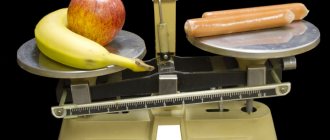Almost every person has floor scales. People want to constantly monitor changes in body weight. But it often happens that digital floor scales show different values when used regularly. This can happen for several reasons. Firstly, the device may be a fake, which is why it will show inaccurate readings. The second factor is surface roughness. The third reason is that definitions are made in different places. This is why scales show weight incorrectly.
How to distinguish electronic models from mechanical ones
The main difference between mechanical devices and digital ones is the presence of a measuring scale with an arrow. Their design consists of a main body and a scale located under glass. They are connected to each other thanks to a transmission mechanism consisting of rocker arms and shoulders.
Mechanical models do not have high accuracy, and their resolution is ±1 kg. Electronic devices show more accurate numbers. Their scale clearly displays the value not only in kg, but also in grams. On ordinary devices, grams are very difficult to see. Therefore, modern models have a lower resolution ranging from 100 to 500 g.
The transmitting device of the devices produces a change in the spring, so it displays on a scale the load exerted on them. Such models should be used on an ideal, flat surface to reduce the percentage of error.
On modern devices, instead of a scale, there is a display that displays the mass. Their measurement principle is based on the sum of the readings of all sensors that have high sensitivity; they are located in the corners of the equipment body. They read how much pressure is applied to the platform.
Rules for using electronic scales
To ensure that electric scales last a long time, you must not:
- Expose them to temperature changes;
- Wash them under running water;
- Shake or drop sharply;
- Place the device in direct sunlight;
- Bring the scales to heating (heating) devices;
- Use chemicals for cleaning.
Important! If you have ruled out all the problems outlined in the article, then most likely the scale needs repairs, and it needs a repairman!
Subscribe to our Social networks
Rules for care and use
To increase service life, you must adhere to the following rules:
- Follow the humidity regime recommended in the instructions;
- Protect from mechanical damage;
- Treat all details with care.
For a more accurate result when weighing, it is necessary to place the mechanism only on a flat surface. Measurements must be carried out in the same constant place. Otherwise, the scales will lie. The legs on the scales should be placed parallel to each other so that the center of gravity is distributed evenly over the entire surface. When standing, you do not need to make unnecessary movements or bend over. Otherwise, the scale shows the wrong weight.
A very common question is: “can scales show different values if used incorrectly?” Yes they can, the conditions under which the device is stored and used are of no small importance.
Reasons why electronic scales show incorrect weight
Why the display may show different weights:
- The surface under the device is uneven. Electronic models are very sensitive devices, so if they wobble when you stand on them, it means that the surface underneath them is uneven, and you should look for another place for them in the apartment;
- Formation of blockage. If the device is used for a long time and stored without a box on the floor, it could simply become clogged. It is necessary to disassemble it and carefully clean all elements with a brush with soft bristles;
- Failure in work. This problem may be caused by incorrect weighing rules. Recommendations to follow when weighing are given below.
Selection Guide
When purchasing, you should carefully study the main characteristics. First you need to determine with what frequency you plan to use it, under what conditions the operation will take place, and the possible percentage of error. It is best to purchase models from well-known manufacturers in this industry.
Well-known manufacturers of reliable mechanical scales:
- Medisana 40461 PSD
- Scarlett SC-BSD33M952
- Maxwell MW-2656
Well-known manufacturers of reliable electronic devices:
- Beurer GS 27
- Starwind SSP5452
- Redmond RS-719PK
Advantages of mechanical devices:
- Long period of use;
- Easy to operate;
- High strength;
- Low price.
Flaws:
- Large error in indicators;
- Lack of additional functions;
- They have limits in their work.
Positive qualities of digital models:
- They have great functionality;
- High accuracy and high limit in measurements;
- Huge selection of models.
Negative sides:
- High cost;
- Requires more careful care;
- It is necessary to constantly replace batteries or connect to the power supply.
When choosing, pay attention to the fact that sensors are built into all legs of the scales, in this case the indicators will be more accurate. Many buyers are often interested in whether devices can give incorrect readings. Despite all the advantages, the devices still show incorrect body weight. There can be many reasons for this: from incorrect installation to device failure.
Selection Guide
In order to avoid problems with purchased scales in the future, you should listen to the opinions of experts who recommend paying attention to the following points when purchasing:
- If you come across a model with a choice of units of measurement, make sure that kilograms are present in the table.
- For use in the bathroom, you should buy a model with moisture protection.
- For comfortable use, choose floor scales with a rough surface rather than a smooth one.
- When choosing a material, it is better to trust metal models rather than plastic ones.
- Don't skimp on your purchase. Cheap models don't last long, the weight they display isn't always accurate, and you'll end up overpaying for repairs or buying a new scale.
- Be sure to check the measurement accuracy before purchasing.
- When working with scales on a carpet, the calculation error can be up to 10%.
- Do not use models that are not designed for your weight.
- Magnetic radiation from instruments located in the room can affect the quality of weighing, so make sure that the scales are located away from radio equipment.
- When purchasing electronic models, choose a model with 4 sensors. This information is not always indicated on the price tag, so you will have to look at the device’s passport.
- The more built-in functions a device has, the greater the error in their calculations. Try to choose simple and reliable models.
Do not forget that electronic scales operate on batteries, which need to be changed at least once every 6 months.
During weighing, do not bend over or step from one foot to the other. Scales sensitive to any changes will show different weights. The cause of inaccurate results here will be you, not the measuring device.
Step on the scale with your clothes on
If you want to know how much you weigh and not your favorite sweater, you need to take it off. The best results will be obtained if you measure your weight while wearing only your underwear. Also remember to take off your shoes.
Knowing and avoiding the listed mistakes, you can get a reliable result. In this case, you will control your weight correctly, avoiding unnecessary worries about gaining a few kilograms.
Found a violation? Report content
Using a Digital Scale
Despite the fact that modern scales are designed to display not only body weight, but also some other parameters, their accuracy is not always high. When using digital scales, even the smallest movements can affect the result. When it comes to mechanical scales, you can calibrate the scale by setting the needle exactly to zero before each use for a more accurate measurement.
Let's read the hand: how to easily identify a traitor by the lines on the palm
The pros and cons of early rise are named
The vernal equinox is coming soon: astronomers have calculated the date of the beginning of spring
Possible breakdowns
If electronic floor scales show different weights, most likely the device is broken. The type of failure can be determined by certain signs:
- No data on the display - the most likely reason is the lack of constant power. Simply put, the batteries are dead. The batteries must be removed and replaced with new ones. Often this problem appears as an error on the display, so troubleshooting is not difficult. How to replace the batteries in floor scales yourself, read our article.
Outputting an incorrect value
The main problem that arises when using electronic scales is that the device shows different body weights.
For what criteria to choose accurate floor scales, read our article.
What should I do if my digital bathroom scales don't work?
If the electronic floor scales do not work and do not turn on, then the cause may be dead batteries. To make sure that the problem is the power source, remove the battery and test it on any working electronic device. If the device with this power source also does not function, then replace the batteries and the scales will not need further repairs.
Important! Sometimes, a tablet (battery) removed from the scales can work on another electronic device, but this does not mean that it is suitable for the scales. Find a brand new battery or other power source that can supply 3V DC to the terminals. If the scales work, then it is not advisable to carry out further repairs.
As for buttons, simple models do not have them at all. And, in more expensive models, the buttons are usually touch sensitive, so most likely the problem is not in the buttons.
Important! The most important thing that the owner of electronic scales needs to remember is that you cannot touch the display! The display is beyond our capabilities. You must not touch any fasteners on the display, screws, or glue that secures the display - if air penetrates under the sealed glass, the polarization of the crystals will be disrupted, and the screen will turn black with unsightly streaks.
Types of scales
Modern household scales come in two types: mechanical and electronic. Mechanical ones have an analog dial, often small, with a division value of 1 kg. Accordingly, the accuracy they provide when weighing is +/- 0.5 kg. For most people who just want to know approximately their weight, this option is suitable. However, for athletes, as well as in medicine, such accuracy is not enough. Electronic scales provide results with an accuracy of up to 100 grams (there are models that show every 10 g). The value is displayed on the screen. Advanced models of scales have additional functions, for example, a built-in calculator/body analyzer, which allows you to calculate the proportions of the body by component composition directly during weighing.
Electronic scales with body composition analyzer
Structurally, electronic scales consist of some kind of sensor and a system for displaying the result. Simple inexpensive copies have a spring sensor, the data from which is digitized and shown on the display. Newer models have a strain converter. Such devices have maximum accuracy, as they are completely electronic. Most often, they have built-in intelligent systems that allow one to determine additional information about the state of the body.
How to fix electronic scales?
If the problem is not the batteries and you are determined to repair the electronic floor scales yourself, follow these instructions.
Step 1: Disassemble the device
First of all, the device must be disassembled. To do this, remove 2 3-volt batteries to de-energize the device and unscrew the bolts on the bottom cover
Step 2: Conduct a visual inspection
Under the cover you will see 4 legs, a printed circuit board, a battery compartment, a screen with buttons and wires connecting all these elements. The front and rear legs have a slight difference - a rubber ring and additional contacts with wires. When you press the scales for the first time, the rubber ring should flatten and the contacts should close, and as a result, the scales will turn on. After turning on, the device waits for both buttons to close, this will mean that the person has stepped on the scale with both feet.
After carefully examining everything, examine:
Step 3: Identify the mechanical problem and fix it
After a visual inspection, determine the nature of the problems and begin repairs:
- Solder any loose wires back into place.
- If the cable connecting the board and the display does not fit tightly, then lift the board a little and press it against the display as tightly as possible.
- Then take a small wooden block and install it at the bottom of the body. Thus, the block will act as a retainer.
- If the scales stop working due to dust and debris getting into them, clean the device. Do this carefully so as not to damage the contacts and microcircuits.
- If the internal frames are bent, level them using standard measuring tools: building level, angle, caliper. This malfunction can occur if an overweight person steps on the scale and bends the legs.
- If the tracks of the electronic board are damaged, then clean the defect area with fine sandpaper, degrease and tin. On top of the damage, solder a jumper or a large layer of tin. Finally, cover the damaged area with varnish (nail polish will also work).
- If the scales have been used for a long time, the contact ends of the device have become thinner. Find the relay in which they are worn out and replace the contacts. Also solder the contacts for reliability.
Important! Typically, all mechanical damage leads to incorrect device readings. Once you have repaired all the damage, the scale will be fully restored. However, if a visual inspection does not reveal any damage, then proceed to the next step - repairing the load cell.
Step 4: Determine the problem using a tester
If the scales are visually in order, then use a tester to find the problem:
- Carefully unsolder each sensor from the board.
- Measure the resistance between the three wires.
- In all 4 corners the indicators should be the same; if there is a gap somewhere, then a breakdown has been detected.
Troubleshooting instructions:
- Carefully pick out the glue (compound) covering the plate. Remember that any mechanical damage to a part can lead to complete failure of the unit.
- Inside there will be a copper plate with three wires. If one of the wires is torn off, restore the electrical connection.
What to do if the problem is in the sensor?
If the sensor is completely faulty, then you can find another one with identical parameters so that the scales do not “lie” too much.
Important! Once you find a new sensor, there is a calibration problem because each sensor is unique, even if two of them came off the same production line. Therefore, bridge connections are guaranteed to be in error.
In order not to use special equipment for calibration, there are small tricks that will help correct the situation with a broken sensor:
- Simply free him from the load.
- Using ordinary resistors, simulate the desired no-load values.
In the first case, the trick will work if the sensor was incorrectly calibrated earlier or lied. And in the second case, the process is simple, because you have already measured the resistance. Simply disconnect the faulty sensor and let it act as a leg (the adders will count the weight of this leg as zero), and connect the remaining sensors according to the diagram and place them inside the case.
Important! Repair of scales may be necessary if they were incorrectly calibrated. To restore it: press the power button and hold until you see the word CAL on the screen. Then the digital mass value will appear. It is with its help that you perform calibration. To do this, use any object whose weight you know for sure. Place the item on the scale. After a few minutes, the word PASS will appear on the display. Remove this label and turn off the scale, and then turn on the device again.
Step 5: Assemble the device
Put all the parts in place, insert the batteries into the compartment, tighten the bolts. Perform control weighing.
As you can see, repairing electronic floor scales is not so difficult, because it is just a bunch of resistors and a small electronic board. But if the scales are under warranty, then entrust this matter to professionals.
How to make the scale show correctly
First you need to determine whether the device is actually reporting information incorrectly. To do this, it is recommended to weigh yourself 5 times in a row, recording the results. The difference between the maximum and minimum values will be the error permissible for home floor scales. If it exceeds 50–300 g, then the device is faulty. However, this procedure will be objective only if the problems described above (malfunctions, manufacturing defects, calibration violations) are excluded.
It happens that devices that have not been used for a long time glitch when turned on or at certain parameters. If the display shows LO, the battery needs to be replaced. When the error cannot be resolved by rebooting (turning the scale off and on) or by thoroughly but carefully cleaning the internal elements, specialist intervention is required.
Advice! On the Internet you can find many tips and video tutorials for DIY repairs. It is worth remembering that even repeating the actions on the video requires certain knowledge and skills. Otherwise, the device may be permanently damaged.










